12/10: Despite the lovely view of the bay from our rental property on the island of Raiatea, Steven and I were only too happy to bid it goodbye and head on to Bora Bora. We were so over the tiny space, the ladder to the bedroom, the long distance to any stores or sights, and we were really looking forward to what we hoped would be a more positive stay on the next island.
This Daily Travelogue is a labor of love for our families and friends at home and around the world. Prior to 2020, all our trips were documented on separate, yearly blogs which can be accessed below. Remember that clicking on any picture will open it for better viewing. Also, please consider adding your name at the end of any comments. Be safe, stay healthy, and stay connected.
Tuesday, January 18, 2022
12/10 & 11/21: Onto BEAUTIFUL Bora Bora!
The 'view' from our seats in the back of our property owner's jeep en route to Raiatea's tiny airport:
After six hours of waiting in the airport's waiting room, our flight finally left for the short hop over to Bora Bora. Though Westerners call the island Bora Bora, the 'b' sound doesn't exist in the Tahitian language, it's actually Pora Pora which means 'first born' as it was the first island created after Raiatea. Historians believe that Tongan travelers may have reached the island centuries ago based on its traditional name of Vava'u. Bora Bora was visited by Captain James Cook in 1769 and 1777. The island was annexed by France in 1895.
Bora Bora is described as "everyone's idea of a South Pacific island" with "dramatic basalt peaks soaring 700 meters above a gorgeous multicolored lagoon." Not surprisingly, the island's main business is tourism for the local population of just nine thousand people who live in three villages.
Some fun trivia: Novelist James A. Michener was a young naval officer who later penned perhaps the most enduring legacy by modeling his Bali Hai on the enchanted island of Bora Bora.
It was just a short 15-minute flight to Bora Bora, the shortest flight we've ever been on and, one that I think is tied with the shortest flight in the world! I thought much later it might have been fun to take the ferry between the two islands. It certainly would have been far, far faster than having to wait hours at the airport.
Bora Bora's airport was on its own motu, Motu Mute. Lots of smaller motorboats had assembled to pick up those guests staying at the high faluting resorts! We always knew who 'they' were as hotel representatives were present in the small terminal to hand out floral garlands to them. Those of us not staying at the plush resorts got on a communal catamaran to the island's main town of Vaitape on the other side of the bay.
No doubt the most amusing airport sign we've ever seen: Aeroport de Bora Bora!
The ferry ride from the airport terminal to Vaitape was longer than the flight to Bora Bora!
The ferry terminal waiting area:
This was the first time I'd seen someone with so many floral garlands!
Vaitape Harbor:
Were we ever relieved to find our rental property near Vaitape was so, so much nicer than each of the preceding properties we'd had in French Polynesia! We were so over having to climb up a narrow ladder to get to the loft and having no AC for the previous five days. The property owners kindly met us at what we were glad to call a 'real' villa and presented us with beautiful leis.
That evening Steven and I rode bikes that had been provided with the villa into Vaitape and were happy to find lots of food trucks or roulottes in the city park as the restaurant selection was pretty sparse. The origin of roulottes in French Polynesia dates back to the 1930s when they emerged among Chinese immigrant families in need of money. When the first roulottes appeared, the Chinese sold fruits and vegetables from their bamboo carts.
In the 1950s and 1960s, they evolved into mobile mini-markets that moved around neighborhoods to prevent residents from making the trip to shops. Then they gradually came to a standstill on land or public squares like this one to sell pancakes and even whole meals for people to come and dine there. Now they are equipped for the preparation of meals and are real family businesses, spanning several generations.
All the roulottes in Bora Bora offered mainly the same dishes characteristic of Polynesia, such as different preparations of raw or cooked fish and grilled meats accompanied by fries. Because of the roulottes' Chinese heritage, it made sense that dishes such as the typical chao men, an assortment of Chinese noodles with vegetables sautéed with meat, were also available. None of the food truck employees appeared to be Chinese however.
12/11: Weeks earlier, Steven had reserved a morning boat and snorkeling tour so we could explore Bora Bora from the sea. We had left ourselves plenty of time to bike into Vaitape and walk around the harbor and look more closely at the vibrant murals.
Thank goodness their brakes worked before hitting the water!
Diego was our young but very capable and knowledgeable boatman for what ended up being a private tour with H2O Bora Bora. He was born in Paris but grew up mostly in the Dominican Republic on a boat before moving to French Polynesia for his university studies.
He told us he hoped to show us both stingrays and manta rays - the latter would be half the size of his boat but have no sting and are the most harmless of rays. If we were lucky, we might also spot some moray eels which were the biggest eel species in French Polynesia.
He searched for eagle rays in one spot but was unsuccessful so we moved on to another, again with no luck. He mentioned how some boat tour operators go to 'feeding spots' where representatives have sent employees out to feed the fish shortly before the boats would arrive with tourists to ooh and ahh at the plentiful fish. We appreciated how H2O Bora Bora adhered to the No Feeding law that had been passed in the 1970s even if it meant we wouldn't see everything.
Before we donned our masks, snorkels, and fins at our first snorkeling spot, Diego explained that we needed to stay in a group to ward off predators! As my underwater camera had gone kaput a couple of days ago, I took these first three just with my camera phone from the boat.
Diego told us that a few fish came to the boat upon hearing the motor as it may have been near where fish had been fed before.
The owner of H2O Bora Bora kindly allowed me to use the following photos from their Facebook page in the blog.
At first, this purple-colored coral looked really, really stunning. That was until Diego mentioned that it's called encrusting coral because once it lands on another type of coral, it literally begins to encrust and take over the entire coral until the original one is no longer visible.
We loved spotting these tiny bright blue fish darting in and around the coral, often finding hiding places if they felt threatened.
Don't hold me to it but I think these were manta rays. Though the picture was taken on Bora Bora, Steven and I saw lots of them also on the boat tour to Taha'a off Raiatea a couple of days previously.
This and the following photo were my favorite types of coral, not obviously because of their colors, but because of their feathery textures. Even though they looked soft, they packed a mean punch if one came too close!
If you're a numbers or facts and figures person like yours truly, you'd be interested in knowing that there are a whopping 850 types of coral in the world, 184 of which are in this island paradise.
Steven and I didn't actually see this rose-colored tubular coral while snorkeling in Bora Bora with Diego but we did see the same odd shape one several days later while snorkeling by ourselves on our last island of Moorea.
These tailfin tang fish were the most common in all the islands we snorkeled in French Polynesia. By the way, Diego let us know there are 118 islands in FP - guess there would be no reason to see the same ones if we were ever to return!
Diego dove down and picked up a clam identical to this one to show it to us up close just for a moment before returning it to where he had found it. Suellen: It looked initially just like one of the pretty lacy scarves you make until we noticed it opening and closing its 'lips' or whatever the correct term is while it was breathing! We saw the same type of clam in several different colors while snorkeling in three separate locations that day with Diego.
It was another indication of how healthy the ecosystem was in Bora Bora, according to Diego.
Diego said he was pretty sure this extral large overwater, two-story residence cost $10,000 a night as it included its own jacuzzi and mini pool! No matter how much money we had I couldn't ever see wasting that much on a night's sleep.
Diego pointed out a largish condo development close to the airport.
Diego told us this was a cleaning station without clueing us in as to what that was, or, at least, neither Steven nor I heard him. It wasn't until I began research for this post that I figured I'd better look it up! I learned that manta rays gather in large quantities in this part of the lagoon to get cleaned by small fish. Mantas visit this and other cleaning stations daily to get their skin, gills, and teeth cleaned by small cleaner wrasse. Manta rays come close to small isolated coral patches found in the middle of the sandy bottoms where the small cleaner wrasse live.
Click on either of the next two photos to look at the tattoo-like designs on the boats. They resembled some of the heavily tattooed French Polynesian men and women we saw on the islands!
The water by the coral garden was so incredibly clear I was able to take these photos with my camera phone. I so wish my underwater camera had been working to capture a photo of a stingray we spotted from the boat that had really long pincers.
About twenty minutes earlier, Diego realized the life preserver was missing from the back of the boat. That caused a massive search for a pretty small item in the huge lagoon with each of us hanging over the sides of the boat looking for the preserver. Kudos to Diego's eagle eyes who spotted the preserver on the beach and swam out to retrieve it!
Once the preserver was safely back on board, we began the journey back to Vaitape which entailed going past a number of top notch resorts.
The first was the Four Seasons Resort:
A little further on was the St. Regis Resort.
The Meridian Resort was under renovation. I wondered with Covid affecting people the world over whether there was much of an impetus to complete the renovations.
The last resort Diego pointed out was the Intercontinental Le Moana near the southern tip of Bora Bora.
Our ears perked up when Diego said it was very close to the island's only public beach, Matira Point, as it wasn't too far from where we were staying!
We appreciated Diego's not shortening the length of our tour after looking for the life preserver. He made sure to still take the time for us to snorkel in a mind-boggling beautiful coral garden. I hope these shots from above the water give you an idea of how absolutely stunning it was under the water.
Diego told us since there were only 32 miles around the island it would only take an hour to drive around all of Bora Bora.
Happy as a clam Steven!
Later that day we rode into Vaitape to grocery shop and then bike around part of the island.
It seemed like 'every' female tourist we'd seen the last ten days was wearing a pareo which seemed very similar to the sarong that we'd seen all over Asia. I learned the main difference is where they originated. Pareos are what the long rectangles of body wrapping fabric are called in French Polynesia, whereas sarongs come from Indonesia.
I was really intrigued by the hundreds of pareo patterns I saw in this store and came so close to buying one but finally couldn't wrap my head around what I'd 'do' with it back home in Denver. Yes, I could have used it as a wall hanging, pillow cover, etc, but after all our international trips, we don't have room for anything else on the walls and Steven already has issues with the pillow covers I couldn't part with from the Middle East. Long story short - no pareo came home!
What made this fruit stand unusual among all the stands we'd seen in the other islands was that someone was tending it. It seemed sad that it was so small and we saw very, very few people ever stop at any of the stands we saw in our three weeks on four different islands.
This bumpy lane was one of several tsunami evacuation routes we saw while on Bora Bora. I wondered if people had to evacuate this past weekend when the underground volcano erupted in not-too-distant Tonga.
Next post: Biking to, and then relaxing at, Matira Beach all day long!
Posted on January 18th, 2022, from sunny Palm Springs, California, where we came for a few days to celebrate Steven's birthday today. I don't think it was any warmer today than Denver as we hiked in nearby Joshua Tree National Park which was almost a mile high like Denver's altitude but it was a great escape!
Subscribe to:
Post Comments (Atom)













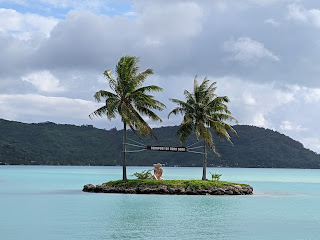




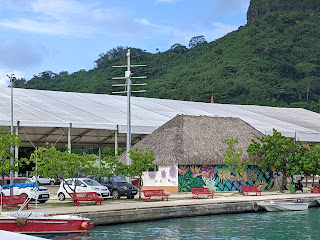










































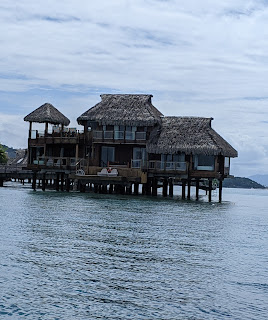
















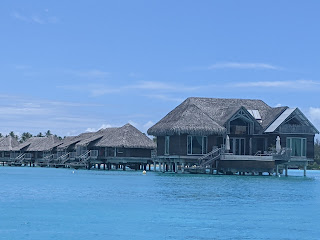










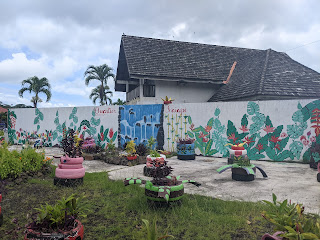






I think Steven is happy as a coral...yuk. Loved the pink tire pig also. Great post. thanks for sharing
ReplyDeleteChris P
Chris,
ReplyDeleteCute one saying Steven looked happy as a coral in that one shot! I also liked what people had done with excess tires.
Annie